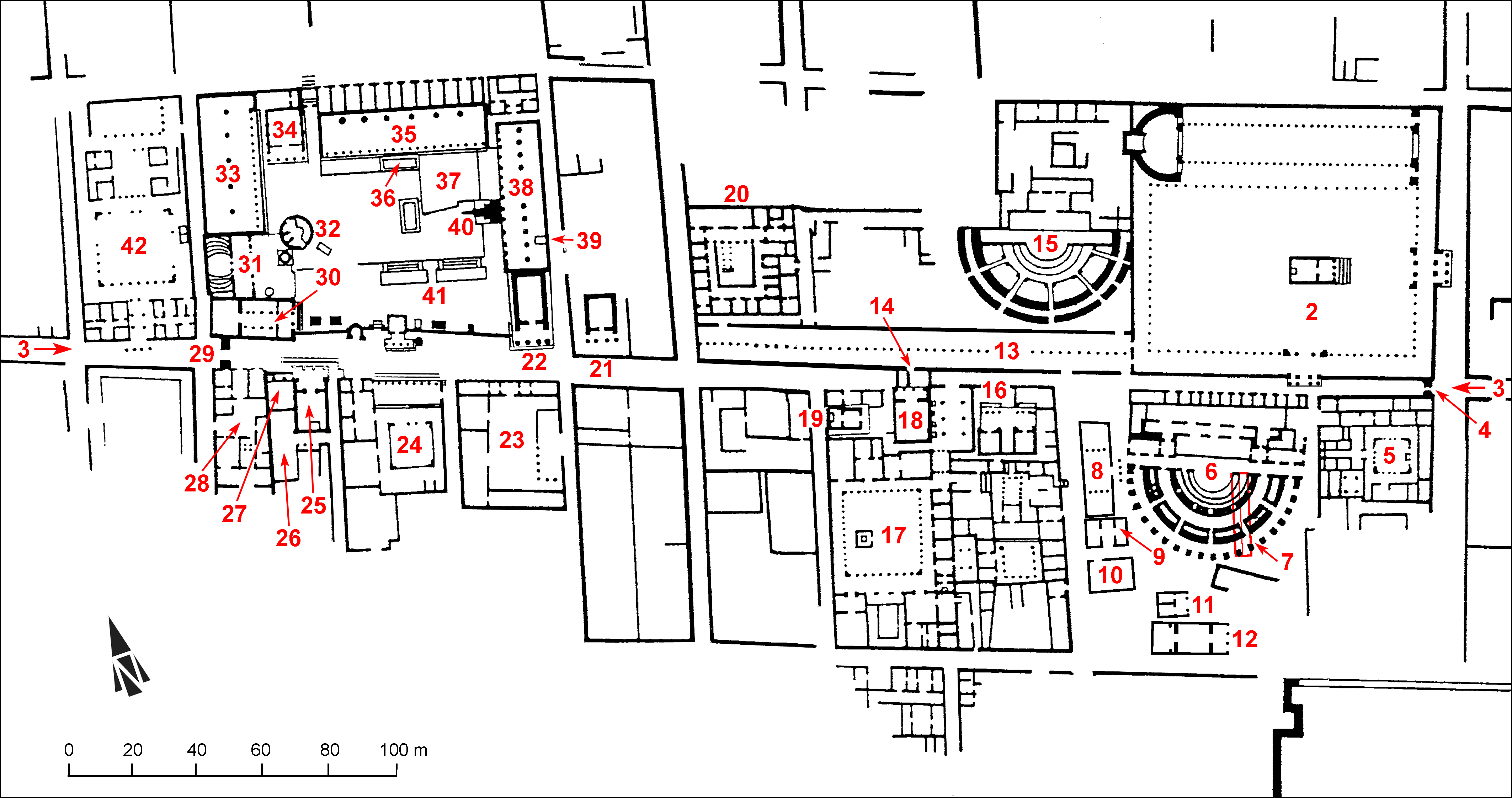EpiDoc XML:
IGCyr0974002
Trismegistos ID:
738491
Source description
Support: Rectangular white marble base, formerly used for IGCyr0975002 on the opposite side. On top, a circular hole near the right edge and two dovetail holes at left near fore and back edges: they might date either to the first or the second use or even after them. The base was slightly re-cut at left after the present use. The estimated original width of the base, inferred from the layout of IGCyr0975002 was 1.01 (present dimensions w: 0.87 × h: 0.29 × d: 0.62).
Layout: Inscribed on four lines on back side of IGCyr0975002; the lines probably ran on the whole width.
Letters: 0.022 to 0.025; light serifs, large circular letters, slanting sigma, phi with flattened loop.
Date: Between 144 and 116 BC (titulature).
Findspot: Found in 1936 at Cyrene ➚: on the agora.
Place of origin: Findspot.
Last recorded location: Seen by C. Dobias-Lalou in 2010 at Cyrene ➚: in the so-called Temple of Hermes.
Text constituted from: Transcription from stone (CDL).
Bibliography
Oliverio XVI.11, whence SECir, 117a (photo); Sammelbuch 1574; Bagnall 1973, pp. 123-124; Piejko 1981, pp. 105-107, whence SEG, 31.1574; Robert, BE, 1982.491; Van't Dack 1987, pp. 327-330; IGCyr 097400 ➚. Cf. Mooren 1977, pp. 33-36; Lanciers 1988, pp. 431-433, whence SEG, 38.1671.
Text
Apparatus
1: [Βασιλ]έ̣α SECir: [Ἀπόλλωνι· Βασιλ]έ̣α Piejko 1981; [---Βασιλ]έ̣α Van't Dack 1987 || [θεῶν Ἐ]πιφανῶν Bagnall 1973: [τὸν ἐκ? θεῶν Ἐ]πιφανῶν Van't Dack 1987; [τὸν ἐγ θεῶν Ἐ]πιφανῶν Piejko 1981; [τῶν Ἐ]πιφανῶν SECir || [συν μακ?]ρῶι: [---ἀργυ?]ρῶι Van't Dack 1987; [οἱ σὺν νικηφό]ρωι Piejko 1981; [ἀργυ]ρῶι SECir; [σιδη]ρῶι SECir
4: [εὐνοία]ς̣ ἕνεκεν: [---] ἕνεκεν Van't Dack 1987; [ἄλλοι, ἀρετῆς] ἕνεκεν Piejko 1981; [c. 5] ἕνεκεν Bagnall 1973; [εὐνοίας?] ἕνεκεν SECir
French translation
(scil. La statue du) roi Ptolémée, grand Dieu, Evergète, fils des Dieux Epiphanes, (scil. a été consacrée), par les gardes du corps aspirants [avec le long?] épieu, les hypaspistes (i.e. écuyers), les soldats d'élite et bien d'autres en raison de sa bienveillance et de sa générosité envers eux.
English translation
(scil. The statue of) king Ptolemy, great God, Euergetes, son of the Gods Epiphaneis, (scil. was dedicated) by the body-guards cadets [with the long?] spear, the hypaspistes (i.e. esquires), the choosen soldiers and many others on behalf of his goodwill and generosity towards them.
Italian translation
(scil. La statua del) re Tolemeo, Grande Dio Evergete, figlio degli Dèi Epifani, (scil. è stata dedicata) dai cadetti delle guardie del corpo [con la lunga?] lancia, dagli hypaspistes (i.e. scudieri), dai soldati scelti e da molti altri per la benevolenza e generosità nei loro confronti.
Arabic translation
(تمثال) الملك بتوليميوس (بطليموس)، المُؤله المُعظم، إفيريغيتس، ابن المؤلَّهان إبيفانيس، (كُرِس) من قبل نائب الحُراس الشخصيين [مع الطويل؟] الرمح، وحملة الدروع (المحترمين)، والجنود المختارين وآخرون كُثر لخيره وكرمه عليهم.
Commentary
For the whereabouts of the stone, see commentary at IGCyr0975002.
This dedication of a statue of king Ptolemy VIII Euergetes II by diginitaries has been commented and restored without exact consideration of the dimensions of the gap at the beginning of the lines. The missing part may be estimated from the opposite side. Pugliese Carratelli at SECir was right in restoring 4 to 6 letters, whereas Piejko's restorations (Piejko 1981) are too long.
Especially at line 3, Piejko's proposal was sceptically received by the Roberts at Robert, BE1982.491 who did not understand the supposed meaning; furthermore, Piejko's argument that συβίνη is a feminine is not fully convincing, as a masculine συβίνης did also exist.
At line 4, εὐνοίας does not deserve Piejko's scepticism, see for example IGCyr0630002.
Lanciers 1988 has shown that Ptolemy bore the title Euergetes already when king of Cyrene, i.e. from 164 on.
CC BY-NC-SA 4.0 Deed Attribution-NonCommercial-ShareAlike 4.0 International License.
All citation, reuse or distribution of this work must contain a link back to DOI: https://doi.org/10.60760/unibo/igcyrgvcyr2 and the filename (IGCyr000000 or GVCyr000), as well as the year of consultation.


